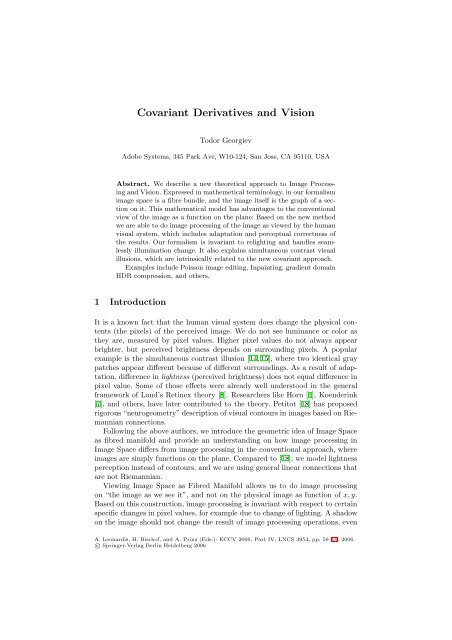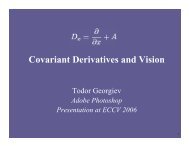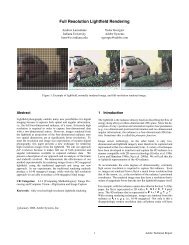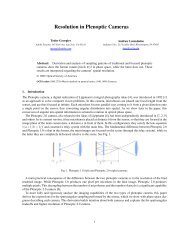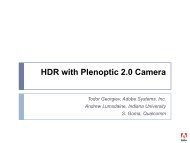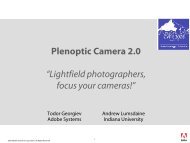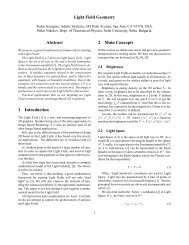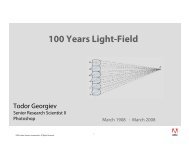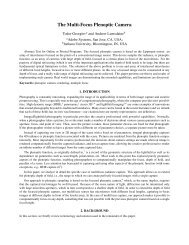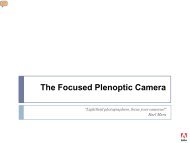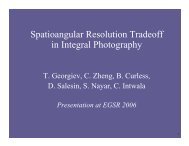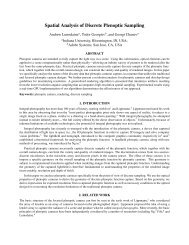Covariant Derivatives and Vision - Todor Georgiev
Covariant Derivatives and Vision - Todor Georgiev
Covariant Derivatives and Vision - Todor Georgiev
Create successful ePaper yourself
Turn your PDF publications into a flip-book with our unique Google optimized e-Paper software.
<strong>Covariant</strong> <strong>Derivatives</strong> <strong>and</strong> <strong>Vision</strong><br />
<strong>Todor</strong> <strong>Georgiev</strong><br />
Adobe Systems, 345 Park Ave, W10-124, San Jose, CA 95110, USA<br />
Abstract. We describe a new theoretical approach to Image Processing<br />
<strong>and</strong> <strong>Vision</strong>. Expressed in mathemetical terminology, in our formalism<br />
image space is a fibre bundle, <strong>and</strong> the image itself is the graph of a section<br />
on it. This mathematical model has advantages to the conventional<br />
view of the image as a function on the plane: Based on the new method<br />
we are able to do image processing of the image as viewed by the human<br />
visual system, which includes adaptation <strong>and</strong> perceptual correctness of<br />
the results. Our formalism is invariant to relighting <strong>and</strong> h<strong>and</strong>les seamlessly<br />
illumination change. It also explains simultaneous contrast visual<br />
illusions, which are intrinsically related to the new covariant approach.<br />
Examples include Poisson image editing, Inpainting, gradient domain<br />
HDR compression, <strong>and</strong> others.<br />
1 Introduction<br />
It is a known fact that the human visual system does change the physical contents<br />
(the pixels) of the perceived image. We do not see luminance or color as<br />
they are, measured by pixel values. Higher pixel values do not always appear<br />
brighter, but perceived brightness depends on surrounding pixels. A popular<br />
example is the simultaneous contrast illusion [14, 15], where two identical gray<br />
patches appear different because of different surroundings. As a result of adaptation,<br />
difference in lightness (perceived brightness) does not equal difference in<br />
pixel value. Some of those effects were already well understood in the general<br />
framework of L<strong>and</strong>’s Retinex theory [8]. Researchers like Horn [6], Koenderink<br />
[7], <strong>and</strong> others, have later contributed to the theory. Petitot [18] has proposed<br />
rigorous “neurogeometry” description of visual contours in images based on Riemannian<br />
connections.<br />
Following the above authors, we introduce the geometric idea of Image Space<br />
as fibred manifold <strong>and</strong> provide an underst<strong>and</strong>ing on how image processing in<br />
Image Space differs from image processing in the conventional approach, where<br />
images are simply functions on the plane. Compared to [18], we model lightness<br />
perception instead of contours, <strong>and</strong> we are using general linear connections that<br />
are not Riemannian.<br />
Viewing Image Space as Fibred Manifold allows us to do image processing<br />
on “the image as we see it”, <strong>and</strong> not on the physical image as function of x, y.<br />
Based on this construction, image processing is invariant with respect to certain<br />
specific changes in pixel values, for example due to change of lighting. A shadow<br />
on the image should not change the result of image processing operations, even<br />
A. Leonardis, H. Bischof, <strong>and</strong> A. Prinz (Eds.): ECCV 2006, Part IV, LNCS 3954, pp. 56–69, 2006.<br />
c○ Springer-Verlag Berlin Heidelberg 2006
<strong>Covariant</strong> <strong>Derivatives</strong> <strong>and</strong> <strong>Vision</strong> 57<br />
if it changes pixel values. A good edge detection (or face detection) system is<br />
not influenced by change of lighting.<br />
We discuss in detail one example of how this new approach works: Writing<br />
the Laplace equation in terms of connections automatically improves the results<br />
of Poisson image editing [10]. Other examples include Inpainting [2], Gradient<br />
domain high dynamic range compression [5], <strong>and</strong> the Bilateral filter [13], [4].<br />
2 Image Space as Fibred Manifold<br />
2.1 Motivation<br />
Intuitively, our approach can be described as follows. A grayscale image is not<br />
a collection of pixels, but a collection of “fibres”. Instead of each pixel having<br />
brightness, we have “a mark” on each fibre. The bundle of fibres is “dynamic” in<br />
the sense that we can freely “slide” fibres relative to one-another. This happens<br />
as part of the Retinex-type adaptation of our visual system. Even though the<br />
mark on the fibre (pixel value) remains the same, its relation to the other fibres<br />
is different. This creates the preception of lightness as different from luminance.<br />
On a more rigorous level, we propose to use the mathematical concept of<br />
Fibre Bundle [12], [9]. It assumes no a priori relation among fibres, other than<br />
topological. The relation (comparison between fibres) is added later, when we<br />
introduce a connection. It gives meaning to pixels by making comparison of<br />
lightness possible.<br />
The relation among pixels is to some extent ’added’ by the observer <strong>and</strong> is<br />
due to both pixel value <strong>and</strong> adaptation of the visual system. If captured in<br />
appropriate mathematical formalism, this will influence image processing.<br />
The ultimate goal is to be able to do image processing on the internal image<br />
that we see, while actually touching only the physical pixels.<br />
2.2 Image Space<br />
In the traditional approach grayscale images are represented as surfaces in R 3 :<br />
Pixels are defined by their coordinates x, y in the image plane, <strong>and</strong> their corresponding<br />
values z in R + . Thus, the conventional model of image space is<br />
Cartesian product of the image plane <strong>and</strong> the positive real line of pixel values,<br />
R 2 ×R + . This structure contains two natural projections: For any point in image<br />
space we can immediately say which pixel it is, <strong>and</strong> what the pixel value is –<br />
according to the two components of the Cartesian product. In this model the<br />
image is a function z = f(x, y), <strong>and</strong> there is a natural comparison between any<br />
two pixel values: simply z2 − z1. It is customary to assume that brightness of<br />
different pixels can be compared in this way.<br />
However, as noticed in section 2.1, there are examples of same pixel values<br />
appearing different or difference in lightness not equal to difference in pixel value.<br />
Retinex <strong>and</strong> other adaptation theories are fundamentally based on considering<br />
this difference between pixel values <strong>and</strong> lightness.
58 T. <strong>Georgiev</strong><br />
The fact that the human visual system does not compare pixels by their luminance<br />
alone, suggests that we need a model of image space in which pixel values,<br />
even if well defined, are not comparable a priori. It should be possible to add<br />
comparison or “difference in observed lightness” later, after a given adaptation.<br />
We propose a model that replaces the Cartesian product structure of Image<br />
Space with a Fibred Space structure (see also [7]). The new structure is “weaker”<br />
because it “forgets” (in the mathematical sense) one of the projections (on z).<br />
In this paper we will show on several examples how this fibred space structure<br />
can be useful. Intuitively, the new structure is essentially a Cartesian product<br />
with one of the projections relaxed. By having the freedom of introducing this<br />
projection later (based on the concept of connection) we gain control on effects<br />
of adaptation.<br />
This situation is similar to the model of space-time in classical mechanics [9].<br />
There is a natural projection on time, in the sense that all observers have one<br />
absolute time. For example, they can synchronize their watches.<br />
However, there is no natural projection onto space. One observer thinks that<br />
a given object does not move: It is always “here”, in the sense that projection<br />
onto space is giving the same location at any time. However, another observer<br />
who passes by in a car would see that this same object moving. It projects onto<br />
different locations in space throughout time. Projection onto space is different<br />
for different observers!<br />
In this way, space-time in classical mechanics is not simply a Cartesian product<br />
of space <strong>and</strong> time. Space in mechanics is relative, it depends on how we define<br />
the second projection. Time is absolute. Space acts like our “fibres” in images<br />
- it depends on the frame of reference or, which is the same, on the observer.<br />
Current pixel values are simply one possible set of coordinates for the image, like<br />
the coordinates of objects relative to one particular observer (in a given moving<br />
car). Other pixel values may describe the same mental image.<br />
To continue the analogy, velocity in mechanics is like perceived gradients in<br />
images. It is different from the point of view of different observers, just like<br />
perceived image gradient depends on the state of adaptation of the observer.<br />
2.3 Fibred Space<br />
By definition [12], a Fibred Space (E, π, B) consists of two spaces: total space<br />
E <strong>and</strong> base space B, <strong>and</strong> a mapping π, called projection, of the total space onto<br />
the base. Space B has lower dimension than E, somanyE points map to the<br />
same B point, as shown in Figure 1.<br />
In our model of grayscale images the total space is R 3 , the base is the image<br />
plane, <strong>and</strong> π gives us the location of each pixel in the image plane. There is no<br />
mapping that would give us the grayscale value of lightness for a pixel.<br />
For each point p ∈ B there is the so-called fibre (Fp in Figure 2) in E, consisting<br />
of all points that are sent to p by π (definition of fibre). We cannot compare<br />
the lightness of two points from different fibres because in the mathematical<br />
structure there is no mapping that would produce that lightness. Each fibre has<br />
its luminance coordinate, but luminances in different fibres are not related.
Fig. 1. Fibred space (E, π, B)<br />
<strong>Covariant</strong> <strong>Derivatives</strong> <strong>and</strong> <strong>Vision</strong> 59<br />
By definition, a section in a Fibred Space is a mapping f that sends points<br />
in B to E, <strong>and</strong> has the property π(f(p)) = p for any p ∈ B. See Figure 2.<br />
Fig. 2. Section in fibred space (E, π, B)<br />
A section selects just one of the many points in each fibre. It defines one<br />
manifold (connected set of points) in total space E, with one point in E for each<br />
point in B. Intuitively it is “the closest we can get to the concept of function<br />
without defining a function”.<br />
A grayscale image is a section in a fibred image space (R 3 , π, R 2 ). Since there<br />
is no projection onto z, there is no comparison between different pixels. As a<br />
result, change in image lightness <strong>and</strong> directional derivative at a point in image<br />
space is not defined. Pixels are simply records <strong>and</strong> come without interpretation.<br />
Luminance or pixel value is a perceptually meaningless coordinate.<br />
2.4 Connections<br />
In fibred spaces changes in the section (slopes of the section) are measured by<br />
the so called connection, orcovariant derivative (instead of derivative). As the<br />
name suggests, connections show how fibres are “connected” or “glued together”.<br />
Connections are used like derivatives to compare pixel values from different fibres.<br />
In Physics [3] the simplest example of such a field is the vector potential<br />
in Electrodynamics.<br />
In order to introduce the definition of connection in a natural way, let us first<br />
consider the gradient when the image is defined traditionally as a function f(x, y)<br />
on the image plane. The gradient is a vector ( ∂f ∂f<br />
∂x , ∂y ) with two components that<br />
are functions of x, y.
60 T. <strong>Georgiev</strong><br />
If the image is defined as a section in a fibred space, the above definition of<br />
gradient does not work because in fibred spaces there is no concept of derivative<br />
or “comparison between different fibres”. Perceptually the situation is similar.<br />
We do not have a sense of comparison between the lightness of different pixels in<br />
the image before assuming some adaptation of the visual system. Pixels are just<br />
“records” without interpretation. In order to compare pixels we need an additional<br />
structure. In our mathematical model this structure is called connection.<br />
A connection on a bundle (E,π,B), where B denotes the image plane, is a<br />
mapping, or a rule, that for any section σ on E produces what is called the x <strong>and</strong><br />
y components of the covariant gradient of that section. These components are<br />
also sections. This mapping has certain properties similar to the properties of<br />
the gradient. In order to come up with a natural definition, let’s look again at the<br />
case of functions. If f = f(x, y) <strong>and</strong>s = s(x, y) are functions on B, the derivative<br />
of the product fs in direction x would be ∂<br />
∂<br />
∂<br />
∂x (fs)=( ∂xf)s + f ∂xs,whichis known as the Leibniz rule for derivative of a product. A similar expression is<br />
valid for the y derivative.<br />
The concept of connection is a generalization of the above Leibniz rule to the<br />
case of sections. By definition, if D is a connection, Dx(fσ)=( ∂<br />
∂xf)σ + fDxσ.<br />
Note that the derivative ∂ acts on a function, while the “derivative” acting on<br />
∂x<br />
the section is Dx. Similar expression is valid for y.<br />
In our image processing applications, a color picture is a section in a vector<br />
bundle, where each three dimensional fibre is a copy of the vector space of<br />
colors. A connection is “adapted (covariant) gradient of color”, as perceived by<br />
the observer. In other words, it shows how the human visual system in a given<br />
state of adaptation perceives directional change of color.<br />
Any section can be represented as a linear combination of a set of basis sections<br />
σi. Inotherwords,σ = Σfiσi. Summation is assumed over i =1, 2, 3, <strong>and</strong> the<br />
coefficients f i are functions. These functions are referred to as color channels<br />
(Photoshop terminology).<br />
By the above definition of connection, Dx <strong>and</strong> Dy would act on a section<br />
σ = Σfiσi in the following way:<br />
Dxσ = DxΣ(f i σi) =Σ(( ∂<br />
∂x f i )σi + f i Dxσi) (1)<br />
Dyσ = DyΣ(f i σi) =Σ(( ∂<br />
∂y f i )σi + f i Dyσi) (2)<br />
These expressions simply extend the Leibniz rule for the action of derivatives<br />
on functions to a Leibniz rule for sections. We don’t know what the action on<br />
the basis section σi is, but we know that the result must be again a section,<br />
representable by the basis. So, it is Dxσi = ΣAj ixσj where Aj ix is some matrixvalued<br />
function of x <strong>and</strong> y. Similar for Dy <strong>and</strong> Aj iy.<br />
DxΣ(f i σi) =Σ(( ∂<br />
∂x f i )σi + Σf i A j ixσj) (3)<br />
DyΣ(f i σi) =Σ(( ∂<br />
∂y f i )σi + Σf i A j iyσj) (4)
<strong>Covariant</strong> <strong>Derivatives</strong> <strong>and</strong> <strong>Vision</strong> 61<br />
As a matter of notation, often the basis σi is dropped, <strong>and</strong> we talk of the<br />
section as represented in terms of f i . Then the action of the connection on fi is:<br />
Dxf i = ∂<br />
∂x f i + ΣA i j xf j . (5)<br />
Dyf i = ∂<br />
∂y f i + ΣA i j yf j . (6)<br />
This expression for the connection, as a replacement of the derivative, will<br />
be our main tool throughout this paper. The rule of thumb is that a connection<br />
Dx, Dy replaces the gradient ∂ ∂<br />
∂x , ∂y according to the so called “minimal<br />
substitution”:<br />
∂<br />
∂x → Dx = ∂<br />
∂x + Ax. (7)<br />
∂<br />
∂y → Dy = ∂<br />
∂y + Ay. (8)<br />
The expression ∂<br />
∂x + Ax <strong>and</strong> similar for y is called the covariant derivative, or<br />
perceptual gradient.<br />
In color images Ax <strong>and</strong> Ay are matrix valued functions of x, y. Ingrayscale<br />
images Ax <strong>and</strong> Ay are functions.<br />
Summary of the result to this point: In fibred spaces changes in the section are<br />
measured by a connection, instead of derivative. As the name indicates, connections<br />
show how we compare, or transfer pixel values from one fibre to another, in<br />
other words - how fibres are “connected”. In Physics [3], connections are called<br />
covariant derivatives. A classical example of connection is the Electromagnetic<br />
field, represented by the vector potential A.<br />
We would like to end this section with a perceptual example of how connections<br />
work in images. The image is a section in a fibre bundle, where we have no<br />
a priori comparison between pixel values in different fibres. As such, the image<br />
is a record without any interpretation. Adaptation, expressed as a connection, is<br />
what gives meaning to pixels, making comparisons possible in terms of lightness.<br />
To make this all more intuitive, let’s look at the example. The simultaneous<br />
contrast illusion, Figure 3 shows that humans do not perceive pixel values directly.<br />
(See [14, 15] for a general survey on lightness perception <strong>and</strong> examples of<br />
illusions.) In the figure there is a constant gray b<strong>and</strong> surrounded by a variable<br />
background. Due to our visual system’s adaptation, the b<strong>and</strong> appears to vary in<br />
lightness in opposition to its surroundings. Pixel gradient is zero, but perceived<br />
or covariant gradient is not zero. The reason why we see change of lightness<br />
in the constant b<strong>and</strong> is the nonzero covariant derivative by which we compare<br />
pixels.<br />
Next we will be working with grayscale images, assuming the generalization<br />
to three color channels is straight forward.<br />
2.5 <strong>Covariant</strong>ly Constant Sections<br />
Following formulas (7) <strong>and</strong> (8), we will be representing any section by the corresponding<br />
function, replacing gradients with covariant gradients. Since now we
62 T. <strong>Georgiev</strong><br />
Fig. 3. The central rectangle has constant pixel values<br />
have a way to compare pixels <strong>and</strong> calculate derivatives, we can ask the question:<br />
When is a given section constant?<br />
Any section g(x, y) can be considered constant relative to appropriately chosen<br />
adaptation Ax,Ay, such that ( ∂<br />
∂x + Ax)g = 0, <strong>and</strong> similar for y. The solution is:<br />
Ax = − 1 ∂g<br />
(9)<br />
g ∂x<br />
Ay = − 1 ∂g<br />
(10)<br />
g ∂y<br />
We are considering Retinex-type adaptation of the visual system, in which the<br />
perceived gradient is the covariant derivative. In grayscale images it is described<br />
by a vector field Ax,Ay). When the visual system is exactly adapted to the<br />
image in a given area, so that (9) <strong>and</strong> (10) are satisfied, we see constant gray<br />
image (or image matching the surrounding color). We call this state complete<br />
adaptation to the image. In practice, due to the unconscious motion of the eyes, a<br />
state of complete adaptation is very difficult to reach. Still, the idea of complete<br />
adaptation will be very useful in the following sections.<br />
3 Test Case 1: Poisson Image Editing<br />
3.1 Equations<br />
It is well known that the Laplace equation △f = 0 with Dirichlet boundary<br />
conditions is the simplest way to reconstruct (or inpaint) a defective area in an<br />
image. It can be used to remove scratches, wrinkles, or bigger unwanted objects.<br />
Let’s write the derivatives in the Laplacian △ explicitly:<br />
∂ ∂ ∂ ∂<br />
f + f =0, (11)<br />
∂x ∂x ∂y ∂y<br />
After performing the minimal substitution (7), (8), the Laplace equation (11) is<br />
converted into the covariant Laplace equation:<br />
( ∂ ∂<br />
+ Ax)(<br />
∂x ∂x + Ax)f +( ∂ ∂<br />
+ Ay)(<br />
∂y ∂y + Ay)f =0, (12)
which after performing the differentiation can be written as<br />
<strong>Covariant</strong> <strong>Derivatives</strong> <strong>and</strong> <strong>Vision</strong> 63<br />
△f + fdivA +2A · gradf + A · Af =0. (13)<br />
Here the vector function A(x, y) =(Ax(x, y),Ay(x, y)) describes adaptation of<br />
the visual system, <strong>and</strong> f(x, y) is the function that represents the grayscale image<br />
as a section. The minimal substitution above is equivalent to the transition from<br />
the conventional image model as a function to the new model of the image as a<br />
section on a fibre bundle. The Laplace equation is converted into the covariant<br />
Laplace equation, which is in fact closer to Poisson equation.<br />
Next we assume A represents complete adaptation to a selected area where<br />
the image is a section defined by g(x, y), translated. The solution of (13) would<br />
be smooth if observed with eyes adapted to g(x, y), but the solution will look<br />
like having g(x, y) “imprinted on it” if observed in some other more typical state<br />
of adaptation. Since state of complete adaptation is practically never achieved,<br />
solving (13) is a way of reconstructing some area with texture similar to g. At<br />
the same time this reconstruction is exact as a model of how the adapted visual<br />
system would “solve” the Laplace equation to fill in the selected region.<br />
Notice that now A(x, y) =− gradg<br />
g can be interpreted as playing the role of<br />
the “guidance field” in Poisson image editing [10]. Substituting in equation (13),<br />
we obtain the final form of the covariant Laplace equation:<br />
△f<br />
f<br />
− 2 gradf<br />
f<br />
· gradg<br />
g<br />
− △g<br />
g<br />
Let’s compare it with the Poisson equation used in [10]:<br />
+2(gradg) · (gradg)<br />
g 2 =0. (14)<br />
△f = △g (15)<br />
We see that the covariant Laplace equation is more complicated than (15). It<br />
can be viewed as a Poisson equation with a modified △g term on the “right h<strong>and</strong><br />
side”. The structure of the equation prescribed by our model is very specific. It<br />
prescribes the expression 2gradf · gradg △g (gradg)·(gradg)<br />
g + f g − 2f g2 as the correct<br />
one to choose as a source term in the modified Poisson equation for seamless<br />
cloning. Equation (15) can be viewed as a simplified approximation.<br />
3.2 Results<br />
One of the practical results of this paper is that the new covariant equation<br />
(14) produces seamless cloning of better quality compared to Poisson editing.<br />
By simple differentiation we can see that (14) is equivalent to:<br />
△ f<br />
= 0 (16)<br />
g<br />
Equation (16) is easy to solve in 3 steps:<br />
(1) Divide the image f by the texture image g, in which pixel value zero<br />
is replaced with a small number. This produces the first intermediate image<br />
I1(x, y).
64 T. <strong>Georgiev</strong><br />
f(x, y)<br />
I1(x, y) =<br />
g(x, y)<br />
(2) Solve the Laplace equation for the second intermediate image<br />
(17)<br />
△I2(x, y) =0, (18)<br />
with Dirichlet boundary conditions defined by I1(x, y) at the boundary of the<br />
reconstruction area.<br />
(3) Multiply the result by the texture image g(x, y)<br />
h(x, y) =I2(x, y)g(x, y), (19)<br />
<strong>and</strong> substitute the original defective image f(x, y) with the new image h(x, y)<br />
in the area of reconstruction.<br />
A multigrid approach to solving (18) with good performance is described in<br />
[11]. In practical terms, the tool works sufficiently fast for using it in interactive<br />
mode. For example, on a laptop running Windows XP with a 2 GHz Pentium 4<br />
processor, applying a brush of radius 100 pixels takes less than 0.25 seconds to<br />
converge.<br />
We apply the algorithm to fix a scratch in Figure 4. Figure 5 shows a zoom<br />
in, where the areas to clone from <strong>and</strong> to clone into are indicated.<br />
Figure 6 (left) shows the result of Poisson Cloning by solving (15), <strong>and</strong> comparison<br />
with <strong>Covariant</strong> cloning based on the proposed method (right). The example<br />
was not selected in any special way. We see that the result is slightly better in<br />
terms of matching the contrast. This behavior is repeated consistently in other<br />
experiments, especially in areas of changing shadows/illumination. Sometimes<br />
the difference between the two methods is big, sometimes - small, but the covariant<br />
approach is always better.<br />
Another example is taken from [16]. The authors use a version of Poisson<br />
cloning to fuse night <strong>and</strong> day images so that in a day image we can see clear<br />
Fig. 4. Basilica San Marco, Venice
Fig. 5. Areas <strong>and</strong> direction of cloning<br />
<strong>Covariant</strong> <strong>Derivatives</strong> <strong>and</strong> <strong>Vision</strong> 65<br />
Fig. 6. Poisson cloning (left) <strong>and</strong> <strong>Covariant</strong> cloning (right)<br />
Fig. 7. Two methods of cloning from the night scene<br />
representation of the night version of the same scene. In Figure 7 the right side<br />
of each image has been modified by cloning from the night image. We see that<br />
Poisson cloning looks blurry, while <strong>Covariant</strong> cloning looks better.
66 T. <strong>Georgiev</strong><br />
4 Test Case 2: Image Inpainting<br />
The method of Inpainting [2] works similar to solving the Laplace equation<br />
to reconstruct the selected area based on the boundaries. However, based on a<br />
higher order PDE related to fluid dynamics the method is able to partially reconstruct<br />
“structure” inside the inpainted area by continuation of the surrounding<br />
grayscale values into the inside. The behavior often resembles fluid flow <strong>and</strong><br />
sometimes is not exactly what we want. Later research attempts to also reconstruct<br />
the texture which is extracted from the surroundings using mathematical<br />
results from functional analysis [17].<br />
Figure 8 compares Inpainting (left) with “Structure <strong>and</strong> texture” Inpainting<br />
[17] (middle) <strong>and</strong> our new method of <strong>Covariant</strong> Inpainting. We would like to<br />
thank G. Sapiro <strong>and</strong> K. Patwardhan for producing the first two pictures. Our<br />
method is equivalent to replacing the derivatives in conventional Inpainting with<br />
covariant derivatives. As in the previous test case, the result is achieved in three<br />
steps. (1) Divide the original image by the texture image. (2) Solve the PDE, in<br />
this case the Inpainting PDE in the selected region. (3) Multiply by the texture<br />
image. We see that our result is better than both previous methods.<br />
Fig. 8. From left to right: Inpainting, Structure <strong>and</strong> texture inpainting, <strong>Covariant</strong><br />
inpainting<br />
5 Test Case 3: Gradient Domain High Dynamic Range<br />
Compression<br />
This section will be a theoretical derivation of previous results. As in previous<br />
sections, the value is in the new theoretical underst<strong>and</strong>ing <strong>and</strong> in showing that<br />
our approach has a wide area of applicability. We will be looking at the invariance<br />
properties of our fibre bundle approach in the case of relighting <strong>and</strong> adaptation<br />
to the new illumination of the scene.<br />
A central problem in dealing with high dynamic range images (HDR) is how<br />
to display them on a low dynamic range device, like a monitor. Just like scratch<br />
removal, the problem of HDR compression can be expressed in terms of relighting.<br />
As an example of how our method works, we will reproduce the results of<br />
one of the best approaches [5] starting from first principles.
<strong>Covariant</strong> <strong>Derivatives</strong> <strong>and</strong> <strong>Vision</strong> 67<br />
Here is a short review of the algorithm of [5]: Treat only the luminance, f.<br />
Calculate logarithm F =lnf; find the gradient of it; attenuate big gradients to<br />
reduce dynamic range; then integrate back to get a real image in log space; <strong>and</strong><br />
finally take the exponent to produce the output luminance.<br />
The logarithm of luminance is used simply because human visual system is<br />
approximately logarithmic, <strong>and</strong> not based on theoretical reasons. Our approach<br />
will provide theoretical justification of the use of logarithm.<br />
The authors minimize the following energy written in log-space<br />
�<br />
( ∂<br />
∂x F − Ax) 2 +( ∂<br />
∂y F − Ay) 2 dxdy (20)<br />
to produce the Poisson equation<br />
△F = divA (21)<br />
for the logarthm of luminance, where A is the attenuated gradient of the log of<br />
the input. “Integrate back” in the above algorithm means “solve (21)”. Without<br />
attenuation, (21) would produce seamless cloning from any image g if A = gradg<br />
g .<br />
We can also write G =lng <strong>and</strong> then<br />
△F = △G. (22)<br />
Now, let’s do the same with our approach. The energy expression is written<br />
based on requirements for adaptation invariance. In other words, a multiplicative<br />
shadow/relighting g on the source image produces an additive to Aµ term in such<br />
a way that the new output image is multiplied by the same shadow/relighting.<br />
This simple requirement for energy invariance produces the result (21), (22),<br />
automatically placed in log-space. The transforms are:<br />
f → gf (23)<br />
A → A − gradg<br />
. (24)<br />
g<br />
The simplest energy expression that has the above invariance can easily be written<br />
using covariant derivatives:<br />
� ∂ (( ∂x + Ax)f) 2 +(( ∂<br />
2<br />
∂y + Ay)f)<br />
f 2 dxdy. (25)<br />
If we substitute A with − gradg<br />
g , the Euler-Lagrange equation for this energy<br />
would be:<br />
△ ln f = △ ln g, (26)<br />
which is exactly (22). In this way, we have found an invariant under (23), (24)<br />
energy expression that reproduces the results of [5].<br />
Because of the logarithm in our result, we reproduce exactly (22), the same as<br />
[5]. What is the difference in our approach? We did not depend on intuition to
68 T. <strong>Georgiev</strong><br />
motivate this use of log space; instead, it comes directly from our mathematical<br />
model based on first principles. This can be seen as theoretical motivation for<br />
using log space in any visual system.<br />
Note that A is adaptation vector field, <strong>and</strong> it can be more general than gradient<br />
of a function. We adapt to what we see, <strong>and</strong> not to the pixel values of<br />
energy illuminating the retina. Due to these adaptation effects, what we see is<br />
not always representable in pixels or as a picture. In other words, the human<br />
visual system can produce internally things that can not possibly be represented<br />
as a picture (on a monitor or other device).<br />
6 Other Test Cases <strong>and</strong> Future Research<br />
As future research we are looking into more rigorous application of our approach<br />
to color images, which are naturally represented as sections in vector bundles.<br />
For example, the above Gradient Domain High Dynamic Range Compression [5]<br />
has been applied only on a grayscale image (or the luminance channel), <strong>and</strong> it<br />
would be useful to see what modifications could we bring with the fibre bundle<br />
approach.<br />
Another test case would be the Bilateral [13] <strong>and</strong> Trilateral [4] filters, which are<br />
treating Image Space in the spirit of Bundles, filtering both in ’Domain’ (image<br />
plane) direction <strong>and</strong> in ’Range’ (pixel value) direction. This type of filtering can<br />
be captured in the mathematical formalism of Jet Bundles [12].<br />
But the main idea of our current paper was that we need to use expressions<br />
for the energy based on connections (covariant derivatives) acting on images<br />
as sections, not functions. This could be done in relation to any PDE or other<br />
image processing algorithm, not just the Laplace equation <strong>and</strong> Inpainting, <strong>and</strong><br />
this defines a wide area of research.<br />
References<br />
1. Adobe Systems: Photoshop 7.0 User Guide. Adobe Systems, San Jose, 2002.<br />
2. M. Bertalmio, G. Sapiro, V. Castelles, C. Ballester, ”Image Inpainting,” Proceedings<br />
of ACM SIGGRAPH 2000, pp. 417-424, ACM Press, 2000.<br />
3. Y. Choquet-Bruhat, C. DeWitt-Morette, Analysis, Manifolds <strong>and</strong> Physics, Amsterdam,<br />
North-Holl<strong>and</strong>, 1982.<br />
4. P. Choudhury, J. Tumblin, ”The Trilateral Filter for High Contrast Images <strong>and</strong><br />
Meshes,” Proceedings of the 2003 Eurographics Symposium on Rendering, pp.186-<br />
196, 2003.<br />
5. R. Fattal, D. Lischinski, M. Werman, ”Gradient Domain High Dynamic Range<br />
Compression,” Proceedings of ACM SIGGRAPH 2002, pp. 249-256, 2002.<br />
6. B. Horn, ”Determining Lightness from an Image,” Computer Graphics <strong>and</strong> Image<br />
Processing, 3, pp. 277-299, 1974.<br />
7. J. Koenderink, A. van Doorn, ”Image Processing Done Right,” Proceedings of<br />
ECCV 2002, pp. 158-172, Springer, 2002.<br />
8. E. L<strong>and</strong>, J. McCann, ”Lightness <strong>and</strong> Retinex Theory,” Journal of the Optical<br />
Society of America, v. 61, no. 1, pp. 1-11, 1971.
<strong>Covariant</strong> <strong>Derivatives</strong> <strong>and</strong> <strong>Vision</strong> 69<br />
9. L. Mangiarotti, G. Sardanashvily, Gauge Mechanics, World Scientific, North-<br />
Holl<strong>and</strong>, 1998.<br />
10. P. Prez, M. Gangnet, A. Blake, ”Poisson Image Editing,” Proceedings of ACM<br />
SIGGRAPH 2003, pp. 313-318, 2003.<br />
11. W. Press, S. Teukolsky, W. Vetterling, B. Flannery, Numerical Recipes in C, Cambridge<br />
University Press, 1992.<br />
12. D. Saunders, The Geometry of Jet Bundles, Cambridge University Press, 1989.<br />
13. C. Tomasi, R. M<strong>and</strong>uchi, ”Bilateral Filtering for Gray <strong>and</strong> Color Images.” Proceedings<br />
IEEE Int. Conf. on Computer <strong>Vision</strong>, pp. 836-846, 1998.<br />
14. M. Gazzaniga, The New Cognitive Neurosciences, MIT Press, Cambridge, MA,<br />
2000, pp. 339-351.<br />
15. A. Seckel, The Art of Optical Illusions, Carlton Books, 2000.<br />
16. R. Raskar, A. Ilie, J. Yu, “Image Fusion for Enhancing Context in Images <strong>and</strong><br />
Video.” ACM Nonphotorealistic Animation <strong>and</strong> Rendering (NPAR) 2004.<br />
17. M. Bertalmio, L. Vese, G. Sapiro, S. Osher, “Simultaneous Structure <strong>and</strong> Texture<br />
Image Inpainting.” CVPR (2) 2003, pp. 707-712<br />
18. J. Petitot, “The neurogeometry of pinwheels as a sub-Riemannian contact structure.”<br />
Journal of Physiology - Paris 97, 2003, pp. 265-309.


